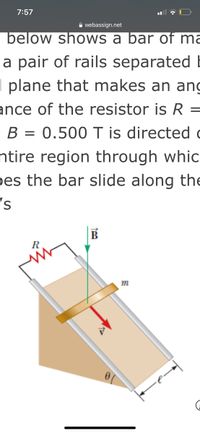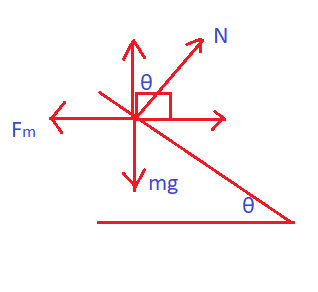Question
The figure below shows a bar of mass m = 0.270 kg that can slide without friction on a pair of rails separated by a distance ℓ = 1.20 m and located on an inclined plane that makes an angle ? = 29.5° with respect to the ground. The resistance of the resistor is R = 3.30 Ω, and a uniform magnetic field of magnitude B = 0.500 T is directed downward, perpendicular to the ground, over the entire region through which the bar moves. With what constant speed v does the bar slide along the rails?
m/s

Transcribed Image Text:7:57
A webassign.net
below shows a bar of ma
a pair of rails separated I
I plane that makes an ang
ance of the resistor is R =
B = 0.500 T is directed
ntire region through whic
pes the bar slide along the
B
Expert Solution
arrow_forward
Step 1
The bar is sliding down with the constant velocity, hence the acceleration of the bar is zero. That means the net force on the bar is zero.
There are two forces acting on the bar, one is gravitational force and the other one is the magnetic force due to the applied magnetic field.
The free-body diagram for the bar is shown in the figure below:

As the bar slides down, there is an induced emf in the loop, and the induced emf is given by
Due to this induced emf, there is an induced current I in the loop and hence the loop experiences a magnetic force.
Trending nowThis is a popular solution!
Step by stepSolved in 2 steps with 1 images

Knowledge Booster
Similar questions
- The drawing shows a copper wire (negligible resistance) bent into a circular shape with a radius of 0.54 m. The radial section BC is fixed in place, while the copper bar AC sweeps around at an angular speed of 19 rad/s. The bar makes electrical contact with the wire at all times. The wire and the bar have negligible resistance. A uniform magnetic field exists everywhere, is perpendicular to the plane of the circle, and has a magnitude of 4.1 x 10-3 T. Find the magnitude of the current induced in the loop ABC. Number i X B www 3.0 92 X Units (into paper) Wire X Xarrow_forwardTwo conducting rails of negligible resistance terminate in a resistor of resistance R = 2.40 Ω The rails are placed in a magnetic field B = 15.0 mT perpendicular to the plane of the rails. The magnetic field is uniform and time independent. The distance between the rails is w = 10.0 cm as shown in the figure. A conducting rod of negligible resistance slides frictionless on top of the two rails at a velocity v = 1.20 m/s + (3.4 m/s2) t, where t is the time, in seconds. The induced current in the circuit at t = 1.00 s isarrow_forwardThe figure shows a bar of mass 0.2kg that can slide without friction on a pair of rails separated by a distance l=1.20m and located on an inclined plane that makes an angle of 25° with respect to the ground. The resistance of the resistor is 1 ohm and a uniform magnetic field of magnitude H=0.5T is directed downward, perpendicular to the ground,over the entire region through which the bar moves. Find the speed at which the bar slides along the rails.arrow_forward
- In the figure, an electron with an initial kinetic energy of 3.80 keV enters region 1 at time t = 0. That region contains a uniform magnetic field directed into the page, with magnitude 0.0100 T. The electron goes through a half-circle and then exits region 1, headed toward region 2 across a gap of 30.0 cm. There is an electric potential difference AV = 2000 V across the gap, with a polarity such that the electron's speed increases uniformly as it traverses the gap. Region 2 contains a uniform magnetic field directed out of the page, with magnitude 0.0168 T. The electron goes through a half-circle and then leaves region 2. At what time t does it leave? Number i Units × B₁ Region 1 Region 2 OB₂arrow_forwardThe loop in the figure has a resistance of 2.5 2 and is being pulled to the right at 1.0 m/s. X X X||X × X 2.0 T X||X 1.0 T 2.0 m X X X ||× × X X X X X • 2.0 m 2.0 m (a) Find the total magnetic flux through the loop, directed into the page, at the time instant shown. b)In the above problem, find the total magnetic flux through the loop, directed into the page, 2.0 s later. (c) In the above problem, find the magnitude of the induced current in the loop during this 2.0 s interval.arrow_forwardA loop of wire with radius r= 0.183 m is in a magnetic field of magnitude B as shown in the figure. The magnetic field is perpendicular to the plane of the loop. B changes from B1= 0.22 T to B2= 7.5 T in Δt = 7.5 s at a constant rate. (a) Express the magnetic flux Φ going through a loop of radius r assuming a constant magnetic field B. (b) Express the change in the magnetic flux going through this loop, ΔΦ, in terms of B1, B2 and r. (c) Express the magnitude of the average induced electric field, E, induced in the loop in terms of ΔΦ, r and Δt.arrow_forward
- L R = 5.00 Q X Xix x 1 |X X X X R P = FexV =8.50 J/s Fext W X xx x X X X X X X X X A rectangular wire loop of length L, width w, is pulled out of a constant, uniform magnetic field with constant velocity v. The loop has a resistance R. The magnetic field of magnitude B, points into the plane of the paper, and is confined to the rectangular region shown above. Work must be done on the loop at the rate of P, to move it through the magnetic field at constant velocity. Find the magnitude of the emf, & and the current I for the loop.arrow_forwardA solenoid in your car is 36 cm long and has a diameter of 7.9 cm. It is made of copper wire with a radius of 0.50 mm. The turns are closely packed and form a single layer. Assume the resistivity of copper is 1.68 ✕ 10−8 Ω · m. (a) When the solenoid is connected to your battery with E = 11.6 V, what is the magnetic field inside the solenoid? (Enter the magnitude.) Tarrow_forwardIn the figure, an electron with an initial kinetic energy of 3.80 keV enters region 1 at time t = 0. That region contains a uniform magnetic field directed into the page, with magnitude 0.00620 T. The electron goes through a half-circle and then exits region 1, headed toward region 2 across a gap of 22.0 cm. There is an electric potential difference AV = 2000 V across the gap, with a polarity such that the electron's speed increases uniformly as it traverses the gap. Region 2 contains a uniform magnetic field directed out of the page, with magnitude 0.0157 T. The electron goes through a half-circle and then leaves region 2. At what time t does it leave? B₁ Region 1 Number i Units Region 2 OB₂arrow_forward
- Asaparrow_forwardA square wire loop (side length 1.5 m) is oriented so that it is perpendicular to an external magnetic field B, with half the area of the loop embedded in the field, as shown below. The loop contains a battery with a constant emf Eb = 7.2 V and a resistor R = 3.2 Ω. The external magnetic field is B(t) = [0.027 T − (0.56 T/s) t] î where î is out of the page. (a) Findtheemfproducedbyinductionintheloop. (b) Findthenetcurrentintheloopfromboththeinducedemfandthebattery. (c) What direction is the current in? (a) Findtheemfproducedbyinductionintheloop. (b) Findthenetcurrentintheloopfromboththeinducedemfandthebattery. (c) What direction is the current in? (a) Find the emf produced by induction in the loop. (b) Find the net current in the loop from both the induced emf and the battery. (c) What direction is the current in?arrow_forwardThe figure below shows a bar of mass m = 0.240 kg that can slide without friction on a pair of rails separated by a distance { = 1.20 m and located on an inclined plane that makes an angle e = 35.0° with respect to the ground. The resistance of the resistor is R = 1.50 N and a uniform magnetic field of magnitude B = 0.500 T is directed downward, perpendicular to the ground, over the entire region through which the bar moves. With what constant speed v does the bar slide along the rails? m/sarrow_forward
arrow_back_ios
arrow_forward_ios